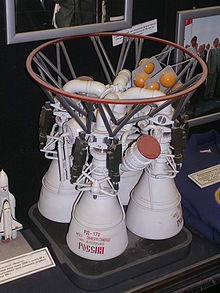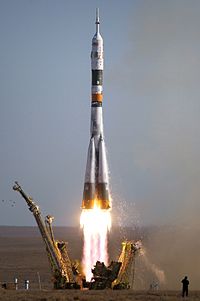- NPO Energomash
-
NPO Energomash “V. P. Glushko” is a Russian manufacturer originated from design bureau, which focuses primarily on the development and production of liquid propellant rocket engines. NPO Energomash is based in Moscow, with satellite facilities in Samara, Perm, and St. Petersburg, and employs close to 5500 workers[1]. Originally founded in 1946 as OKB-456, the company is noted for its long history of large scale LOX/Kerosene engine development, notably the RD-107, RD-170, and RD-180 engines. These engines have functioned as prime movers for such vehicles as R-7, Proton, Soyuz, Energia and Atlas V. NPO Energomash acquired its current name on May 15, 1991, in honor of its chief designer.
Contents
History
Valentin Petrovich Glushko was appointed chief designer of the newly-founded OKB-456 design bureau on July 3, 1946[2]. The company was quickly tasked with the production of a Russian copy of the German V2 rocket engine, under the supervision of Glushko and 234 German designers added to the company in October, 1946. [3][4] At the end of that year, OKB-456 took up residence in an aviation factory near the city of Khimki, just outside Moscow. Here, the bureau constructed facilities to build and test fire its engines. The RD-100 performed admirably, and low-pressure LOX/Ethanol engine development continued, in the form of the RD-102 and RD-103. However, the development of high-pressure engine technology allowed propellants with a higher energy density to be used, and so LOX/Kerosene quickly replaced LOX/Ethanol as the propellant of choice.[5]
Storable Propellants & Hypergols
In 1954, the development and success of the LOX/Kerosene RD-107 and RD-108 engines allowed the company to expand its engine development work further. The RD-214 engine, using a storable mixture of Nitric Acid and Kerosene, was developed for ballistic missiles with a short readiness time requirement. The RD-214 was soon superseded by the RD-216 and later variants, which used a hypergolic combination of UDMH and Nitric Acid. This line of development later led to the highly successful NTO/UDMH RD-253 line, which was the most powerful hypergolic engine of its time, and remains in production to the current day[6].
High Pressure Engines
The RD-107 and RD-108 engines developed from 1954-1957 were extremely reliable and widely used. However, DB Energomash (renamed from the original OKB designation in 1967) saw great potential in the development of LOX/Kerosene engines with a higher chamber pressure. This presented many challenges to the engine designers, most notably the development of a turbopump which could deliver enough propellant to keep the engine running at a pressure high enough to maintain combustion stability. The resulting engine, developed in the early 1980s, was the RD-170, which runs at a chamber pressure of 3500 psi and produces 1.7 million lbf of thrust at a sea-level specific impulse of 309 sec[7] -- one of the most efficient and powerful LOX/Kerosene engines in the world.
Current work
Variants of the RD-170 are still in use today on such vehicles as the Zenit 3SL used by Sea Launch. The modern Soyuz rocket uses updated versions of the RD-107 and RD-108 engines. The RD-180 engine, developed with Pratt & Whitney Rocketdyne through the RD AMROSS partnership, is a direct descendant of the RD-170 line, and is used as the propulsion system for the first stage of Atlas V[8]. The most current engine listed on the NPO Energomash website is the single-chamber RD-191, developed for the Angara and Baikal launch vehicles.
References
- ^ "About The Company." NPO Energomash. 2009. 18 Jan. 2009 <http://www.npoenergomash.ru/eng/about/>.
- ^ "Glushko." Encyclopedia Astronautica. 2008. 18 Jan. 2009 <http://astronautix.com/astros/glushko.htm>.
- ^ Raketensklaven ISBN 9783421066350
- ^ Raketensklaven: Deutsche Forscher hinter rotem Stacheldraht ISBN 978-3933395672
- ^ "History of Company." NPO Energomash. 2009. 18 Jan. 2009 <http://www.npoenergomash.ru/eng/about/history/>.
- ^ "RD-253." Encyclopedia Astronautica. 2008. 18 Jan. 2009 <http://astronautix.com/engines/rd253.htm>.
- ^ "RD-170." Encyclopedia Astronautica. 2008. 18 Jan. 2009 <http://astronautix.com/engines/rd170.htm>.
- ^ Atlas V. 2009. United Launch Alliance. 18 Jan. 2009 <http://ulalaunch.com/docs/product_sheet/AtlasProductSheetFINAL.pdf>.
External links
Categories:- Aerospace companies of Russia
- Aerospace companies of the Soviet Union
- Companies based in Moscow
- Soviet and Russian space institutions
- Space industry companies of Russia
Wikimedia Foundation. 2010.


